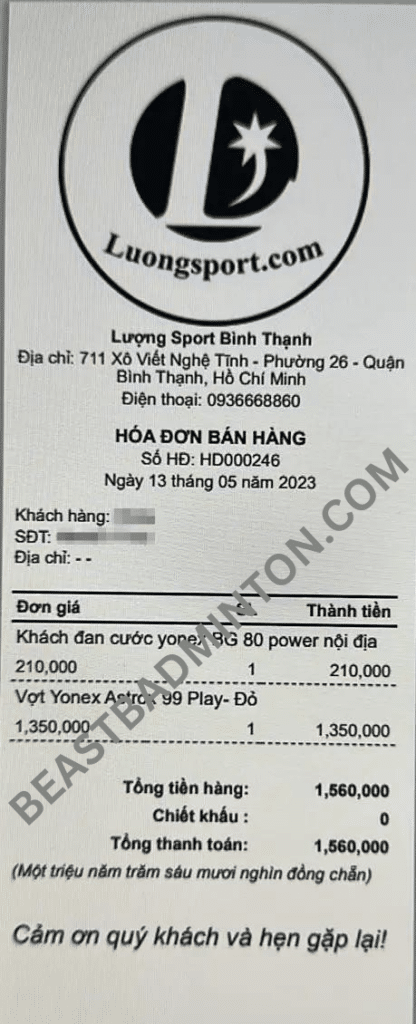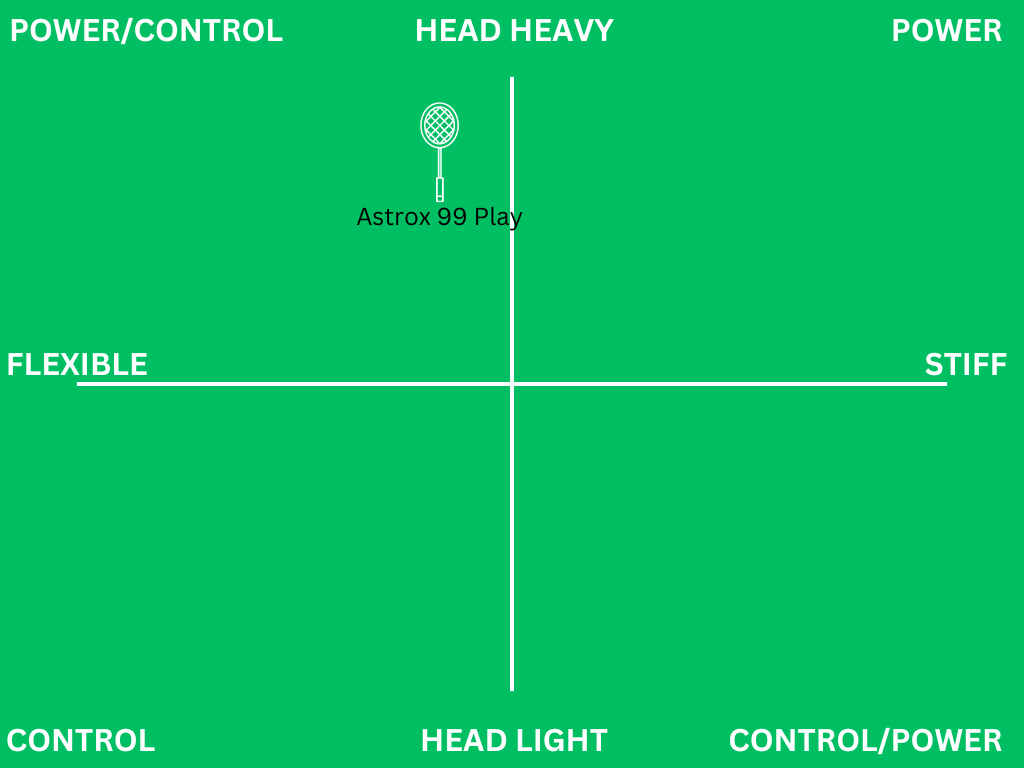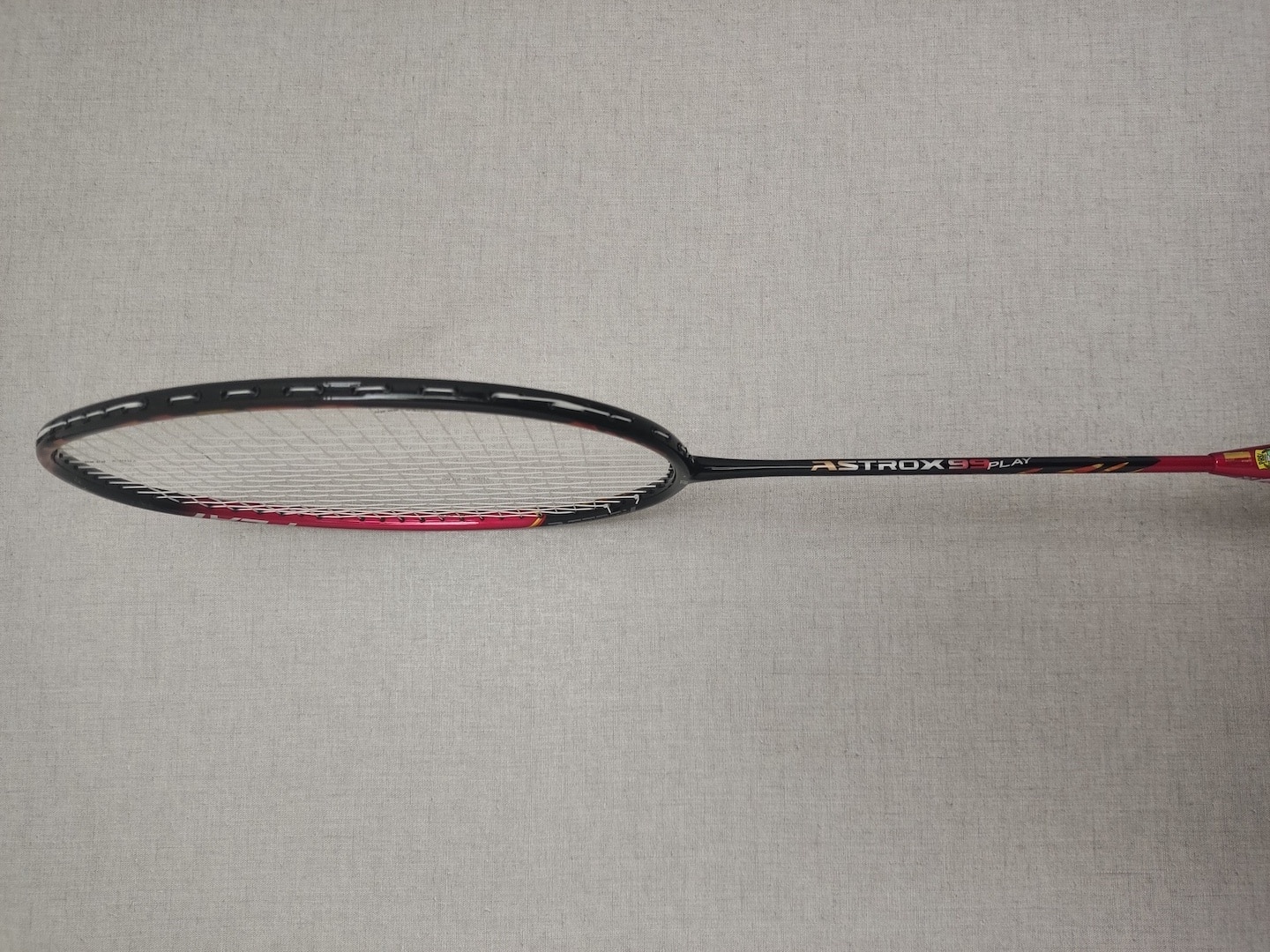
Before diving into the Astrox 99 Play review, let me clear up any confusion about similar rackets.
Yonex’s original Astrox 99 has been replaced with a new range that includes a Pro, Tour, Game, and Play edition. Astrox 99 Play is the beginner and budget-friendly edition of Kento Momota and Kodai Naraoka’s preferred racket, the Astrox 99 Pro.
Compared to other modern attacking rackets, this is a classic powerhouse for beginner players. It’s a beast and if it resembled a comic book character, it would be The Hulk.

In this Astrox 99 Play review, I tested the 4UG5 version and had it on court for about fifteen hours. I immediately got it restrung to my usual Yonex BG80 string, which is a power (repulsion) string to keep my reviews consistent and better compare with other rackets.
Table of Contents
Yonex Astrox 99 Play review
My first impression
Before testing, I made sure to play a game with the Arcsaber 11 Play I had just gotten used to, as it’s as all-around as rackets come and the most recent one I tested.
With less raw power than I usually prefer, I noticed that I had developed more creativity on court as my smash wasn’t as powerful and it made for some interesting gameplay.
Right from the first few shots, I realized that my task was to control the power rather than attempt to extract it. I kept hitting far beyond the backline, to the point that my partner began joking about what I had for breakfast that morning.
First, let’s look at how this racket stacks up in net play for beginner players.
Netplay
Netplay isn’t the easiest part of the game with the Astrox 99 Play as it’s the most powerful beginner racket Yonex offers.
It’s strong but slow rather than swift and nimble. At the net, I often found myself sending the shuttle back over the net in a slow arch, even with the slightest whip, that gave my opponents far too much time to think.
It results in the shuttle flying just too high up over the net and offering your opponent an easy kill if they are quick on their feet.
To avoid selling yourself or your partner out on a return near the net, you’ll be forced to touch the shuttle gently while guiding it around which is tricky if you’re late and moving explosively to get it.
On the other hand, when I was late getting a shot in the front court I found that I could often just put the racket on and it would fly back over the net without much work. I’d live to fight another day.
If you’re a beginner player that’ll make the game more fun as you’ll be able to build longer, intense, rallies in doubles rather than those short five-shot rallies where you’re simply trading points back and forth.
Yonex’s Astrox 99 Play is not particularly suitable for net game and you’ll have to be gentle to keep up here. Using a string that offers control over power might help (see the end of this review for suggestions).
Midcourt and defense
When it comes to defense, the Astrox 99 Play is a mixed bag.
Lifts are effortless and you’ll have to be careful not to send them beyond the backline, while drive duels in doubles games can feel challenging if you aren’t well-prepared. This racket is slow so it’s easy to send the shuttle back with plenty of power, but being precise is tricky just like switching grip and adjusting when the shuttle comes to you.
On the other hand, blocking a power smash is fun as I was often able to simply put the racket on the shuttle and send it back over the net without effort. If you’re well-prepared, you might even be able to turn it into a deadly weapon by guiding the shuttle around the front court and forcing your opponents to work hard on the follow up.
Power
While the Yonex Astrix 99 Play isn’t the most suitable for other areas of the game, it’s in the power segment where it really comes alive.
There’s not much to say about your smash other than it will be powerful.
Flat attacking clears are easy and can win you a good chunk of points in doubles. I noticed that as long as you can keep the shuttle in the court and play it down the middle to cause miscommunication among your opponents, you’ll often win the point outright or get a poor return you can kill.
An odd part of the game where I regularly got in trouble was on flick serves. The Astrox 99 Play’s power makes it easy to clear the shuttle out of the court as you’ll often be around the mid-court when returning a flick.
Granted, I’m not the world’s most skilled flick serve returner.
In general, you’ll give away a bunch of free points if you aren’t hyper-aware of how far up on the court you are when hitting a quick overhead stroke with this racket.
On the other hand, I had no problem getting plenty of power in the shuttle even when I was taking shots late. Shots that are hard to send back beyond the midcourt and often end up offering a free kill if we don’t perform a fast net drop instead.
If I was a betting man, I’d guess that beginners are especially intrigued by this racket. The raw power is fantastic and despite it not being the most flexible racket in the beginner spectrum, I believe many beginners that play badminton regularly and love power, will have fun with this racket. As with many power-based rackets, it can feel a bit like sledgehammer-y but I didn’t find it too bad.
This is as close to a 100% power score as I’ve experienced with a beginner racket thus far. The reason it doesn’t get the full score is due to the flexibility it needs in order to cater to beginners. That takes a bit of the edge at the very top in exchange for making it easier to use.
Control and shuttle hold
The Astrox 99 Play is marketed as a racket with a longer contact point between the shuttle and racket during a hit, as we know it from the Arcsaber 11 Play. The intention is to increase shot precision.
I have to admit that I didn’t notice this much. I didn’t find this racket any easier or more precise than others, but also not harder and that’s the secret.
Power usually comes at the expense of control and since this racket has loads of power, the control and precision would typically be worse if it didn’t wasn’t built with improved shuttle contact.
I found myself misting shots ever so slightly, which is likely because I’m used to stiffer rackets. It wasn’t as much as when I tested the Astrox 77 Play, which is an even more flexible beginner racket.
Conclusion
Overall, this is a fun beginner racket. Especially, if you haven’t honed in your power-generating technique as it’ll enable you to hit the backline more easily and open up new avenues of gameplay to move your opponents around. And of course, you’ll be able to produce a powerful smash.
But. It comes at a cost.
You’ll need to control the temptation of wanting to hit with full power unless you’re far back on the court or confident your next shot will finish the rally.
Yonex Astrox 99 Play offers a one-sided game as it’s not the easiest racket to control during soft hits like net play or drive duels. It feels heavy and slow but nothing out of the ordinary for what you’d expect with a super head heavy racket and I doubt you’ll notice unless you’ve tried higher-end rackets.
Hey reader, a quick interruption... I’m experimenting partnering with webshops that sell badminton gear, like Amazon. I’ll include links to buy the gear I review and if you do, they’ll pay me a small commission. That doesn’t change your price and you’ll get more play-tested gear as a result but I thought it was fair to let you know. As an Amazon Associate, I earn from qualifying purchases. I appreciate your support, Aske
Yonex Astrox 99 Play: the verdict

Summary
The Astrox 99 Play is a fun beginner racket with loads of power.
The trade-off is that it can feel one-sided as it isn’t strong at soft, precise shots near the net.
Overall, it offers good value for money and is a good choice if you know you’d like help generating power in your game.
Yonex Astrox 99 Play marketing and technology
Usually there’s no marketing material specifically for the Play-edition rackets and as far as I’m aware, this one is no exception.
Yonex usually only prepares that for their high-end Pro rackets, so I had to dig into the catalog to figure out what’s advertised there and still built into the more affordable Astrox 99 Play as some parts are stripped away from the Pro.
This is what’s advertised in the Pro.
| Yonex Astrox 99 Play Technology | Description |
|---|---|
| AERO+BOX Frame | A combination of two frame styles. One for power and one for a quick swing |
| ISOMETRIC | Increases the size of the sweet spot (available on all newer Yonex rackets) |
| Rotational Generator System | To generate better whip effect through counter balancing |
| Slim Shaft | To make it easier to slice through the air |
| Power Assist Bumper | Attached at the top of the racket. Increases the momentum and transfers more power to the shuttle |
| Wider grommets designed for more string movement | Translating into control and precision through a longer contact point with the shuttle |
Best player types for Yonex Astrox 99 Play
Next, let’s look at which player types this racket is ideal for and who should avoid it.
The ideal player type
The ideal player type for this racket is a beginner player who plays regularly and is working on improving their technique and timing.
If that’s you and you find yourself struggling to hit backline to backline or just love power and want to win rallies with hard smashes, you’ll like this racket.
The non-ideal player type (you might not like this racket if…)
That being said, if you’re an entry-level player who hasn’t had much time on court and struggles to hit the shuttle in general, this racket might require too much technique.
If that’s you and you’re still intrigued, I’d only consider getting it if you’ve scheduled training with a coach so you know you’ll rapidly be improving your timing when hitting the shuttle. Otherwise, I just don’t think you’ll have fun with it.
On the other hand, if you’re a regular beginner player and often find yourself getting shoulder fatigue when playing from hitting a lot of overhead strokes, you might prefer a racket that’s even balanced or even head light instead. The same is true if you prefer to play the front court in doubles games.
Finally, if you’re an intermediate player, you’ll likely find this racket too flexible for your liking.
Astrox 99 Play compared to other popular rackets
Before looking at the specifications as the final part of this Astrox 99 Play review, let’s compare it to other similar rackets you might be considering.
Yonex Astrox 99 Play vs. Astrox 99 Game, Tour, and Pro
The 99 Play is the beginner and budget-friendly version, whereas the Game is suitable for intermediate players. The Tour and Pro are for advanced players and above due to their stiffness.
Technically, this racket is categorized as medium in the flex scale, which can seem misleading because the medium bracket includes rackets on both sides of the middle: medium-flexible and medium-stiff. This one is on the medium-flexible side.
All four rackets are similar with the key differences being in technology, pricing, and that they are built for different skill levels.
Astrox 99 Play vs. Astrox 100 Game
The reason I’m comparing these two rackets is that the Astrox 100ZZ is popular and in the same ballpark but doesn’t come in a Play edition for beginners. The Yonex Astrox 100 Game is the one that comes closest in terms of skill required from the series.
The power in the two rackets felt similar and you’ll be working to contain it rather than extract it with both rackets.
The Astrox 100 Game feels sharp and fast like a lightsaber compared to the Astrox 99 Play which resembles a classic sledgehammer. I’ve found the 100 Game to be a smoother racket all-around, as it feels swift and faster in other aspects of the game like quick soft shots near the net or even during drive duels in doubles games.
The Astrox 100 Game feels more like playing Fruit Ninja as it slices through the air but it isn’t a fair comparison as it’s more expensive and much stiffer, meaning it requires more skill to handle, than the Astrox 99 Play.
Astrox 99 Play Specifications
| Flex | Medium |
| Balance Point | Head Heavy |
| Weight / Grip | 4U G5/6 |
Recommended Strings
| Yonex’s recommended strings | Control Players: Aerobite Hard Hitters: BG66 Force |
Takeaways
- Yonex Astrox 99 Play is a strong and heavy power racket for regular beginner players
3 comments
Really love your review, can’t wait for you to review other mid/lower end of other brand like victor and lining.
Thanks for the kind words, Andrew. Me too – it’s surprisingly challenging to get a clear understanding of the differences between their intermediate rackets
Glad I’m not the only one then ????. Will continue to wait for your reviews of other intermediate racket cheers.